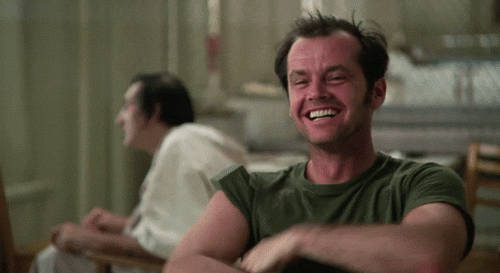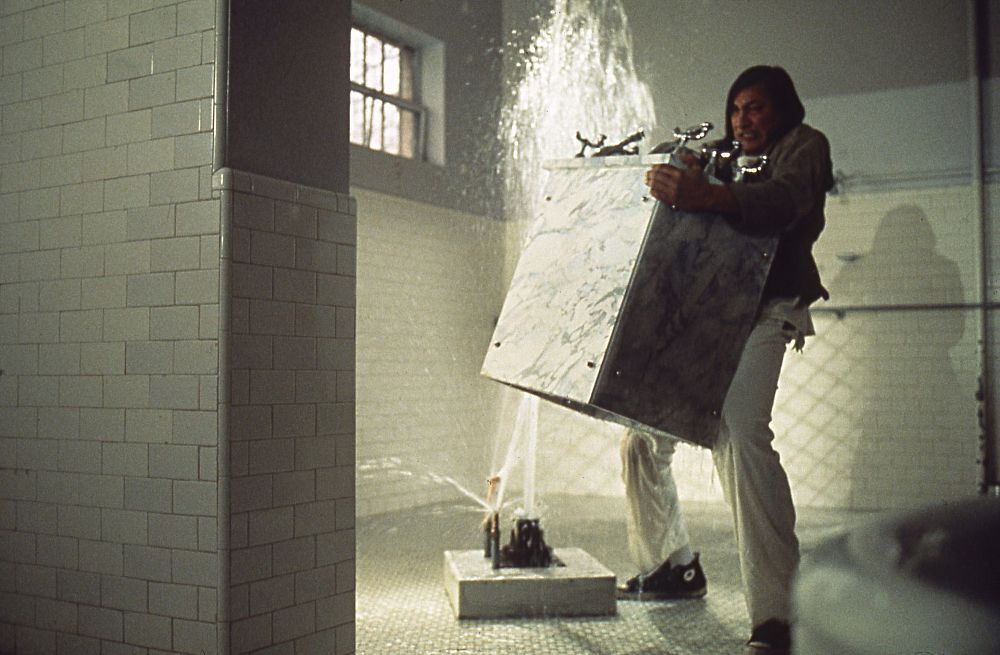What do you think?
Rate this book


281 pages, Paperback
First published January 1, 1962

…a guy has to learn to get along in a group before he'll be able to function in a normal society; how the group can help the guy by showing him where he's out of place; how society is what decides who's sane and who isn't, so you got to measure up.
…people will force you one way or the other, into doing what they think you should do, or into just being mule-stubborn and doing the opposite out of spite.



"He knows that you have to laugh at the things that hurt you just to keep yourself in balance, just to keep the world from running you plumb crazy."



McMurphy laughs. Rocking farther and farther backward against the cabin top, spreading his laugh out across the water – laughing at the girl, at the guys, at George, at me sucking my bleeding thumb, at the captain back at the pier and the bicycle rider and the service station guys and the five thousand houses and the Big Nurse and all of it. Because he knows you have to laugh at the things that hurt you just to keep yourself in balance, just to keep the world from running you plumb crazy. He knows there’s a painful side; he knows my thumb smarts and his girl friend has a bruised breast and the doctor is losing his glasses, but he won’t let the pain blot out the humor no more’n he’ll let the humor blot out the pain.









"Ting. Tingle, tingle, tremble toes,The title of the book was taken from a nursery rhyme but the first 3 and last lines were from the book, i.e., thoughts inside the head of the schizophrenic narrator, Chief Bromden as the nursery rhyme was used to be sung to him by his grandmother when he was young. “Cuckoo” here is used to refer to insane people and “flying over the cuckoo’s nest” means either going too far or leaving the nest. It is also known that cuckoos lay their eggs in other bird’s nests, and do not have nests of their own. The cuckoo, upon hatching, throws the other birds out of the nest out of instinct. (Source: Wiki)
She’s a good fisherman, catches hens, puts ‘em inna pens
Wire blier, limber lock, three geese inna flock
One flew east, one flew west
One flew over the cuckoo’s nest
O-U-T- spells out… goose swoops down and plucks you out."
[image error]
“La cosa contra la que luchaba nunca podía considerarse definitivamente vencida. La única posibilidad era golpearla y golpearla, hasta que uno quedaba sin fuerzas y otro tenía que ocupar su lugar.”La novela es una gran metáfora construida en torno a dos descomunales personajes y contada por un gigante.
“Nadie se queja de la niebla. Ahora ya sé por qué: aunque resulte molesta, permite hundirse en ella y sentirse seguro. Es lo que McMurphy no comprende, que queramos estar seguros. Sigue intentando hacernos salir de la niebla, ponernos al descubierto, donde sería fácil atraparnos.”Todo ello confiere al relato un cierto tono de cuento de hadas en el que se narra el enfrentamiento entre dos fuertes voluntades, la de la maléfica bruja Enfermera jefe y la del valiente y pícaro Randle Patrick McMurphy, dos personajes que permanecerán en sus mentes para siempre.
“McMurphy lo ignora, pero está sobre la pista de lo que yo comprendí hace ya mucho tiempo, que no es únicamente cosa de la Gran Enfermera, sino que es todo el Tinglado, la gran fuerza reside en el Tinglado a nivel nacional, y la enfermera no es más que un oficial de alta graduación dentro del mismo.”Esta lucha va a simbolizar el control que el «Tinglado», encarnado por la Gran Enfermera y sus secuaces y violentos enfermeros, es capaz de ejercer sobre las sociedades indolentes y conformistas, los pacientes, que prefieren la seguridad del control a la responsabilidad y la libertad de elegir y dirigir sus destinos, una metáfora sobre la capacidad manipuladora del «Tinglado» para hacerles olvidar incluso que están siendo controlados y hacerles creer que son ellos los que manejan el cotarro.
“Creo que no tienes una idea muy clara de cómo es el público, amigo; en este país, cuando algo no funciona, todos se inclinan por la solución más rápida.”El problema con el relato aparece cuando la actual sensibilidad choca con ciertos clichés que en la novela son llamativos: las mujeres son putas, enfermeras represoras o madres castrantes, por un lado, y los pacientes son todos blancos, excepto “el jefe” Bromden, que es mestizo, mientras que los violentos guardias/enfermeros son negros, por el otro. Tampoco es un gran acierto por parte del autor presentar con tanta ligereza el delito sexual por el que McMurphy es condenado.


